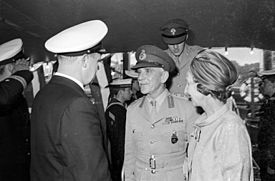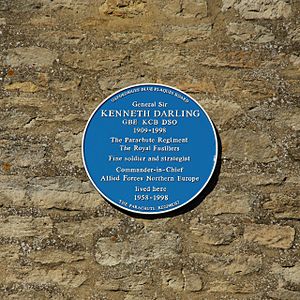Kenneth Darling facts for kids
Quick facts for kids
Sir Kenneth Darling
|
|
|---|---|

General Sir Kenneth Darling (centre) in 1968.
|
|
| Born | 17 September 1909 Bengal Presidency, British India |
| Died | 31 October 1998 (aged 89) Chesterton, Oxfordshire, England |
| Allegiance | |
| Service/ |
|
| Years of service | 1929–1969 |
| Rank | General |
| Service number | 44052 |
| Unit | Royal Fusiliers Parachute Regiment |
| Commands held | 11th Battalion, Royal Fusiliers 12th (Yorkshire) Parachute Battalion 5th Parachute Brigade 16th Parachute Brigade II Corps 1st (British) Corps Southern Command Allied Forces Northern Europe |
| Battles/wars | World War II Palestine Emergency Cyprus Emergency |
| Awards | Knight Grand Cross of the Order of the British Empire Knight Commander of the Order of the Bath Distinguished Service Order |
| Relations | Douglas Darling (brother) |
General Sir Kenneth Thomas Darling (born September 17, 1909 – died October 31, 1998) was an important British Army officer. He served bravely during World War II and later became the Commander-in-Chief of Allied Forces Northern Europe from 1967 to 1969.
Contents
Sir Kenneth Darling: A British General
Sir Kenneth Darling was a highly respected general in the British Army. He was known for his leadership during difficult times. His career spanned many years and included important roles in different parts of the world.
Early Life and Education
Kenneth Darling was born in British India on September 17, 1909. His father, George Kenneth Darling, worked for the Indian Civil Service. Kenneth had a younger brother, Douglas Darling, who also became a distinguished soldier.
When he was older, Kenneth was sent to England for his education. He attended Eton College, a famous school. After that, he went to the Royal Military College, Sandhurst. This is where future army officers are trained.
Becoming a Soldier
On August 29, 1929, Kenneth Darling officially joined the army. He became a second lieutenant in the Royal Fusiliers regiment. He served with his regiment in the United Kingdom and then in India for eight years. He was promoted to lieutenant in 1932 and captain in 1938.
Leading in Wartime
When World War II began in September 1939, Darling returned to the United Kingdom. He attended a special training course for officers. After this, he became a staff officer, helping to plan military operations.
From June 1942, he was the Commanding Officer (CO) of the 11th Battalion, Royal Fusiliers. This meant he was in charge of about 800 soldiers. He led his battalion in North West Europe during 1944 and 1945. For his brave service, he received the Distinguished Service Order award in 1945. At that time, he was serving with the 12th (Yorkshire) Parachute Battalion.
Important Roles After the War
After World War II, Darling continued to take on important leadership roles. In 1946, he became the Commander of the 5th Parachute Brigade. He served with this brigade in Palestine during a period of unrest called the Palestine Emergency.
Later, he commanded the 16th Independent Parachute Brigade in 1950. He also held senior positions at the War Office, which was the main department for the British Army. In 1958, he became the General Officer Commanding Cyprus District during the Cyprus Emergency.
His career continued to advance. He became the General Officer Commanding I (British) Corps in 1962. His final major appointments were as General Officer Commanding-in-Chief at Southern Command in 1964. Then, from 1967 until he retired in 1969, he was the Commander-in-Chief of Allied Forces Northern Europe. This was a very important international role.
Awards and Later Life
Sir Kenneth Darling received several high honors for his service. These included:
- Knight Grand Cross of the Order of the British Empire (GBE) in 1969
- Knight Commander of the Order of the Bath (KCB) in 1963
- Distinguished Service Order (DSO) in 1945
He also held honorary positions, such as Honorary Colonel of the Royal Fusiliers. He was also an ADC General to Queen Elizabeth II from 1968 to 1969.
In 1941, Darling married Pamela Denison-Pender. He lived in Chesterton, Oxfordshire, from 1958 until he passed away on October 31, 1998. A special blue plaque was placed on his former home in 2015 to remember him.


